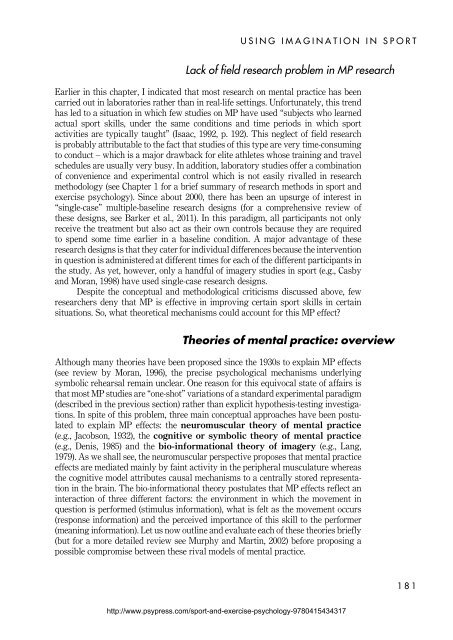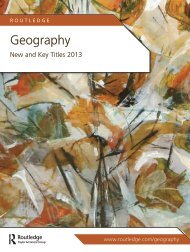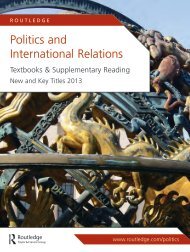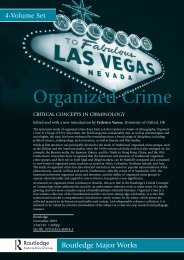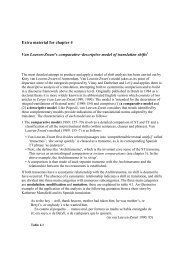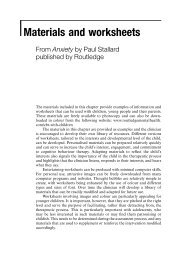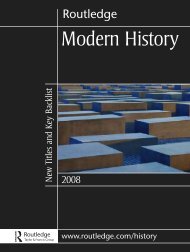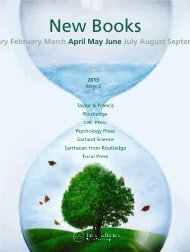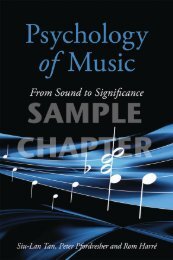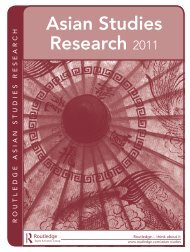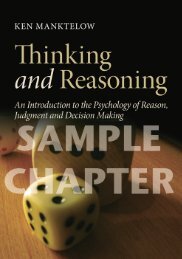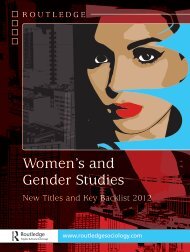Sport and Exercise Psychology: A Critical introduction ... - Routledge
Sport and Exercise Psychology: A Critical introduction ... - Routledge
Sport and Exercise Psychology: A Critical introduction ... - Routledge
Create successful ePaper yourself
Turn your PDF publications into a flip-book with our unique Google optimized e-Paper software.
USING IMAGINATION IN SPORT<br />
Lack of field research problem in MP research<br />
Earlier in this chapter, I indicated that most research on mental practice has been<br />
carried out in laboratories rather than in real-life settings. Unfortunately, this trend<br />
has led to a situation in which few studies on MP have used “subjects who learned<br />
actual sport skills, under the same conditions <strong>and</strong> time periods in which sport<br />
activities are typically taught” (Isaac, 1992, p. 192). This neglect of field research<br />
is probably attributable to the fact that studies of this type are very time-consuming<br />
to conduct – which is a major drawback for elite athletes whose training <strong>and</strong> travel<br />
schedules are usually very busy. In addition, laboratory studies offer a combination<br />
of convenience <strong>and</strong> experimental control which is not easily rivalled in research<br />
methodology (see Chapter 1 for a brief summary of research methods in sport <strong>and</strong><br />
exercise psychology). Since about 2000, there has been an upsurge of interest in<br />
“single-case” multiple-baseline research designs (for a comprehensive review of<br />
these designs, see Barker et al., 2011). In this paradigm, all participants not only<br />
receive the treatment but also act as their own controls because they are required<br />
to spend some time earlier in a baseline condition. A major advantage of these<br />
research designs is that they cater for individual differences because the intervention<br />
in question is administered at different times for each of the different participants in<br />
the study. As yet, however, only a h<strong>and</strong>ful of imagery studies in sport (e.g., Casby<br />
<strong>and</strong> Moran, 1998) have used single-case research designs.<br />
Despite the conceptual <strong>and</strong> methodological criticisms discussed above, few<br />
researchers deny that MP is effective in improving certain sport skills in certain<br />
situations. So, what theoretical mechanisms could account for this MP effect?<br />
Theories of mental practice: overview<br />
Although many theories have been proposed since the 1930s to explain MP effects<br />
(see review by Moran, 1996), the precise psychological mechanisms underlying<br />
symbolic rehearsal remain unclear. One reason for this equivocal state of affairs is<br />
that most MP studies are “one-shot” variations of a st<strong>and</strong>ard experimental paradigm<br />
(described in the previous section) rather than explicit hypothesis-testing investigations.<br />
In spite of this problem, three main conceptual approaches have been postulated<br />
to explain MP effects: the neuromuscular theory of mental practice<br />
(e.g., Jacobson, 1932), the cognitive or symbolic theory of mental practice<br />
(e.g., Denis, 1985) <strong>and</strong> the bio-informational theory of imagery (e.g., Lang,<br />
1979). As we shall see, the neuromuscular perspective proposes that mental practice<br />
effects are mediated mainly by faint activity in the peripheral musculature whereas<br />
the cognitive model attributes causal mechanisms to a centrally stored representation<br />
in the brain. The bio-informational theory postulates that MP effects reflect an<br />
interaction of three different factors: the environment in which the movement in<br />
question is performed (stimulus information), what is felt as the movement occurs<br />
(response information) <strong>and</strong> the perceived importance of this skill to the performer<br />
(meaning information). Let us now outline <strong>and</strong> evaluate each of these theories briefly<br />
(but for a more detailed review see Murphy <strong>and</strong> Martin, 2002) before proposing a<br />
possible compromise between these rival models of mental practice.<br />
http://www.psypress.com/sport-<strong>and</strong>-exercise-psychology-9780415434317<br />
181


